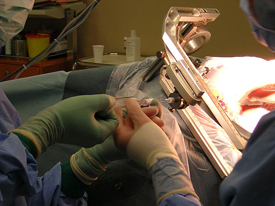A biopsy is a test in which a small piece of tumor or tissue is taken out of the body to be examined for cancer cells. This procedure is done to determine the exact type of cancer that is present. A biopsy can also be done to determine whether the treatment has gotten rid of cancer cells or to monitor continued remission.
 Our Understanding a Biopsy video provides a description of a biopsy to help patients and caregivers feel better prepared for the procedure. By viewing this video beforehand, both caregivers and patients may have less anxiety on the day of the procedure.
Our Understanding a Biopsy video provides a description of a biopsy to help patients and caregivers feel better prepared for the procedure. By viewing this video beforehand, both caregivers and patients may have less anxiety on the day of the procedure.
This video was made possible by a grant from American Legion Child Welfare Foundation.
There are two types of biopsies. The exact procedure depends upon the area that needs to be biopsied and the patient’s age.
- A closed biopsy is when a needle is put into the tissue to obtain a sample without cutting open the skin
- An open biopsy is when the skin is opened during surgery to get a sample of tissue
Some biopsies are done in the operating room under general anesthesia (completely asleep). Other biopsies are done using local anesthesia to numb the skin. The type of anesthesia used will depend on the location of the biopsy.
 Side Effects of Biopsies
Side Effects of Biopsies
- Pain is the most common side effect.
- Sometimes a child may get a skin infection at the entry site, but this is very uncommon.
- Bleeding sometimes occurs under the skin or deep where the needle was placed, causing a black and blue mark.
- Your doctor can explain what to watch for following the biopsy.
Tips for Parents
- You should always feel free to ask questions about what is going to happen. If your child understands what will happen, it will help him or her feel more comfortable and less anxious.
- Books, magazines, games or music may help keep your child entertained while waiting for the biopsy to begin.
- If your child has regular biopsies it can be helpful to have rituals for after the biopsy. Examples of rituals include having your child’s favorite drink, easy to digest food or favorite games available after the procedure.
